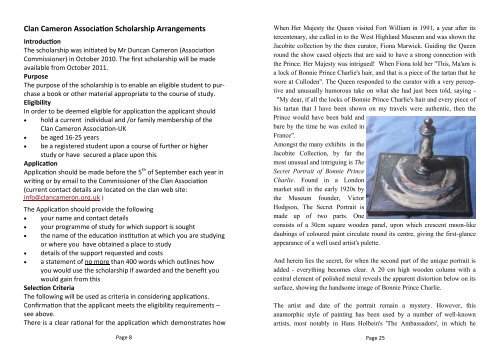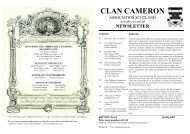Autumn 11 - The Clan Cameron Association Scotland.
Autumn 11 - The Clan Cameron Association Scotland.
Autumn 11 - The Clan Cameron Association Scotland.
Create successful ePaper yourself
Turn your PDF publications into a flip-book with our unique Google optimized e-Paper software.
<strong>Clan</strong> <strong>Cameron</strong> <strong>Association</strong> Scholarship Arrangements<br />
Introduction<br />
<strong>The</strong> scholarship was initiated by Mr Duncan <strong>Cameron</strong> (<strong>Association</strong><br />
Commissioner) in October 2010. <strong>The</strong> first scholarship will be made<br />
available from October 20<strong>11</strong>.<br />
Purpose<br />
<strong>The</strong> purpose of the scholarship is to enable an eligible student to purchase<br />
a book or other material appropriate to the course of study.<br />
Eligibility<br />
In order to be deemed eligible for application the applicant should<br />
hold a current individual and /or family membership of the<br />
<strong>Clan</strong> <strong>Cameron</strong> <strong>Association</strong>-UK<br />
be aged 16-25 years<br />
be a registered student upon a course of further or higher<br />
study or have secured a place upon this<br />
Application<br />
Application should be made before the 5 th of September each year in<br />
writing or by email to the Commissioner of the <strong>Clan</strong> <strong>Association</strong><br />
(current contact details are located on the clan web site:<br />
info@clancameron.org.uk )<br />
<strong>The</strong> Application should provide the following<br />
your name and contact details<br />
your programme of study for which support is sought<br />
the name of the education institution at which you are studying<br />
or where you have obtained a place to study<br />
details of the support requested and costs<br />
a statement of no more than 400 words which outlines how<br />
you would use the scholarship if awarded and the benefit you<br />
would gain from this<br />
Selection Criteria<br />
<strong>The</strong> following will be used as criteria in considering applications.<br />
Confirmation that the applicant meets the eligibility requirements –<br />
see above.<br />
<strong>The</strong>re is a clear rational for the application which demonstrates how<br />
Page 8<br />
When Her Majesty the Queen visited Fort William in 1991, a year after its<br />
tercentenary, she called in to the West Highland Museum and was shown the<br />
Jacobite collection by the then curator, Fiona Marwick. Guiding the Queen<br />
round the show cased objects that are said to have a strong connection with<br />
the Prince. Her Majesty was intrigued! When Fiona told her "This, Ma'am is<br />
a lock of Bonnie Prince Charlie's hair, and that is a piece of the tartan that he<br />
wore at Culloden". <strong>The</strong> Queen responded to the curator with a very perceptive<br />
and unusually humorous take on what she had just been told, saying -<br />
"My dear, if all the locks of Bonnie Prince Charlie's hair and every piece of<br />
his tartan that I have been shown on my travels were authentic, then the<br />
Prince would have been bald and<br />
bare by the time he was exiled in<br />
France".<br />
Amongst the many exhibits in the<br />
Jacobite Collection, by far the<br />
most unusual and intriguing is <strong>The</strong><br />
Secret Portrait of Bonnie Prince<br />
Charlie. Found in a London<br />
market stall in the early 1920s by<br />
the Museum founder, Victor<br />
Hodgson, <strong>The</strong> Secret Portrait is<br />
made up of two parts. One<br />
consists of a 30cm square wooden panel, upon which crescent moon-like<br />
daubings of coloured paint circulate round its centre, giving the first-glance<br />
appearance of a well used artist's palette.<br />
And herein lies the secret, for when the second part of the unique portrait is<br />
added - everything becomes clear. A 20 cm high wooden column with a<br />
central element of polished metal reveals the apparent distortion below on its<br />
surface, showing the handsome image of Bonnie Prince Charlie.<br />
<strong>The</strong> artist and date of the portrait remain a mystery. However, this<br />
anamorphic style of painting has been used by a number of well-known<br />
artists, most notably in Hans Holbein's '<strong>The</strong> Ambassadors', in which he<br />
Page 25




